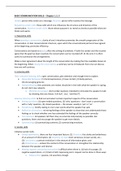Samenvatting
Summary Communication in Organizations
- Instelling
- Radboud Universiteit Nijmegen (RU)
Een compacte samenvatting van het boek 'Communication in Organizations'. Het bevat de meest belangrijke modellen en begrippen van de hoofdstukken 1, 2, 3, 7, 10, 14 en 15 (Tentamenstof). De samenvatting is, net zoals het boek en het tentamen, Engelstalig. Dit boek van Henk T. Van der Molen en Yvon...
[Meer zien]





